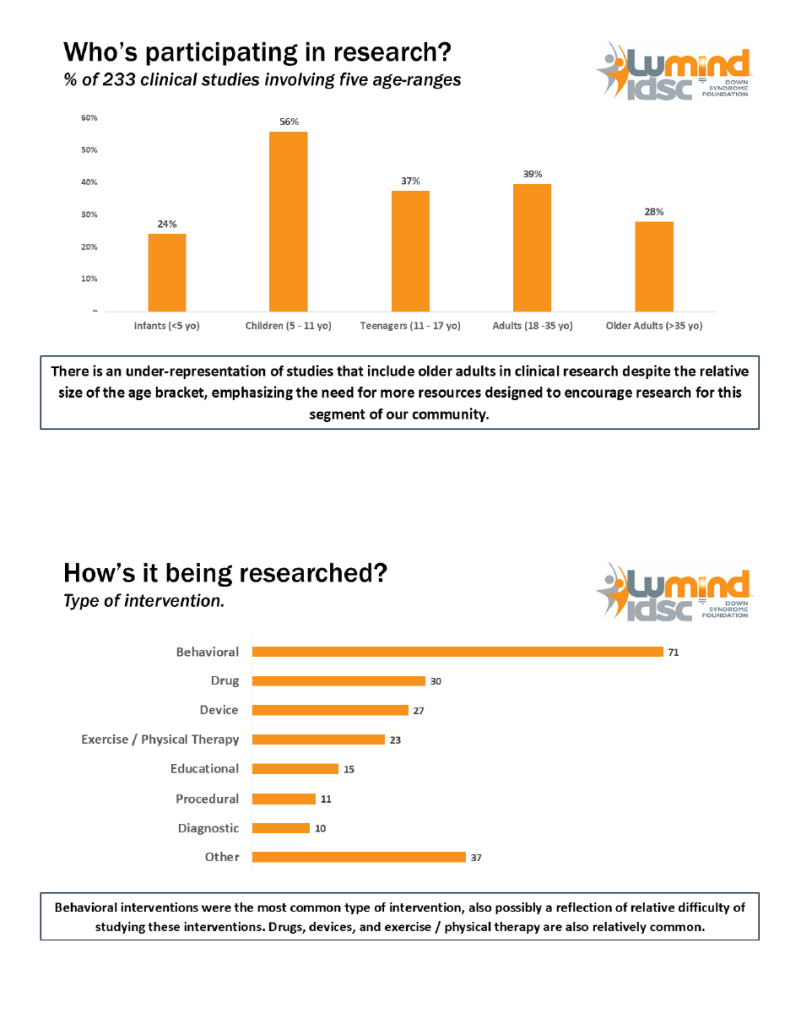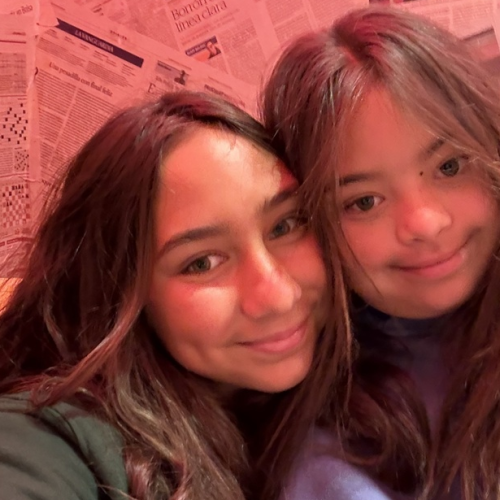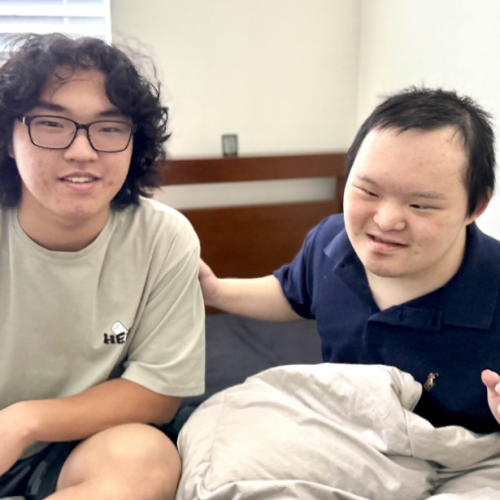This summer, LuMind IDSC welcomed two interns to support our Research department. Alana Brill and Maximus Kono, both rising high school seniors, spent eight weeks creating a special database to augment LuMind’s analysis of Down syndrome research activity.
In addition to designing the database and entering the data, Alana and Maximus also presented research papers on topics of their choosing, which allowed them to dive more deeply into an aspect of Down syndrome research that was of particular interest to them. The following is their report on their database work and research topics.
By Alana Brill & Maximus Kono
In this blog post, we’ll share what we did and our findings. Throughout our internship, we took a look at all 233 Down syndrome studies on clinicaltrials.gov from 2015 to 2025. We then compiled a wide range of data from these studies and put them in a single database. While compiling the data, we asked 4 main questions: Who is doing the research, who is participating in the research, what is being researched, and how is it being researched.
The majority of the research was sponsored by academic institutions, including universities and hospitals, while other studies were sponsored by non-profits, for-profit companies, and government agencies. The website from which the data was collected is the official clinical trial database of the United States government, so our analysis is biased towards the US.. Some countries beyond the US that were home to many study sponsors were France, Spain, and the United Kingdom. However, there were also many non-Western countries like Pakistan, Egypt, and Turkey that have been sponsoring significant amounts of Down syndrome clinical research, which we found interesting and encouraging. Out of the 233 studies investigated, the United States sponsored 107, a significant majority. Sponsors of Down syndrome clinical research are fairly distributed across U.S. states, with Massachusetts (15), North Carolina (9), Kansas (8), Colorado (7), and California (7) ranking as the top five states where study sponsors were located.
Generally speaking, there was a relatively even spread of who was being studied. There were five age groups we considered: infants (<5 years old), children (5-11), teenagers (11-17), adults (18-35), and older adults (>35). It is worth noting that studies can include multiple age groups. Each age group was included in more than 20% of the studies. That being said, the children group (5-11) received significantly more attention than others, with 56% of studies including or focused on children, compared to the older adults (aged >35) only being involved in 28%. We interpreted this as showing there is an under-representation of studies including older adults, suggesting a need to increase research in that area.
3. What’s being researched?
The most frequently studied topic was motor function, which was the focus of 69 studies. As expected, there is also an emphasis on areas such as cognition, sleep apnea, and Alzheimer’s which are high priority for the Down syndrome community. Furthermore, the inclusion of studies on general health and caregiver/family dynamics reflects the wide array of interests within the clinical research community for those with Down syndrome and their families.
4. How’s it being researched?
The studies were mostly interventional, with about 75% of studies including some form of intervention – behavioral, medication, device, or other. Additionally, of the studies that had a clinical trial phase, the majority of studies were phase 1, ½, or 2. This indicates that DS research is still early-on in the pipeline. There was also a relatively even spread of the interventions used to conduct the study. Excluding behavioral interventions, which had 71 studies, there was a relatively even spread of study interventions, with drug, device, and physical therapy all having relatively equal representation.


Congenital heart defects (CHDs) pose a significant health risk within the Down syndrome (DS) community, with alarming statistics indicating that 40-60% of individuals with DS are affected, compared to less than 1% in the general population. This issue resonates with me on a personal level, as my younger sister was born with a minor heart defect. This background motivated me to elect to present on a research paper investigating the relationship between CHDs and DS.
The study, conducted by Balistreri et al. focused on a genetic hypothesis suggesting that overexpression of certain genes on chromosome 21 may be linked to this heightened risk. The research analyzed four specific genes using blood samples from participants with and without CHDs, as well as a control group without DS, revealing that variations in genes such as IFNGR2 and IL10RB correlate with the presence of CHDs in DS. These findings not only enhance our understanding of the genetic basis of CHDs, but also suggest implications for early genetic screening and eventually targeted therapies.
First, I carefully analyzed and synthesized the research paper to fully understand its objectives, methods, and findings. From this analysis, I developed a series of slides that went through multiple revisions, incorporating feedback to refine the content. Finally, I presented my work to the LuMind team and CEO, effectively conveying the significance of the research and its potential impact while ensuring the information was comprehensible and relevant to the Down syndrome community.
This project not only deepened my understanding of congenital heart defects and their genetic factors, but also allowed me to develop skills in analysis and presentation. The project and presentation reinforced the importance of making complex scientific information accessible and valuable, ultimately benefiting those affected by these conditions.
From my work on the database I also improved my time management, organization, and collaborative skills. As a sibling of someone with Down syndrome, the behind-the-scenes examination of research has allowed me a new perspective on Down syndrome clinical research and what goes on behind the public eye. I feel that in some ways I was able to bridge my scientific knowledge of Down syndrome with my community ties.

The study I took a closer look at, by Azab et al, was titled Distinct effects of trampoline-based stretch-shortening cycle exercises on muscle strength and postural control in children with Down syndrome: a randomized controlled study. This study looked at whether or not jumping on a trampoline alongside physical therapy would lead to greater improvements in strength and postural control compared to just physical therapy. They found that trampoline exercises lead to significant improvements in both postural control and strength. The reason this is important is that it could lead to improvements in therapy for people with Down syndrome. Current therapy solutions can be incredibly boring, so I think having fun trampoline-based exercises at the end could improve retention.
When reading and presenting this research paper, I did my best to look at it from the perspective of the community. Personally, I tend to look at studies in isolation, such as the effects of certain therapies. However, during this internship, I began to look at it from the perspective of why and how it could help people. I had to look at ways the knowledge gained from the research could lead to improvements, as well as possible roadblocks that would prevent said improvements.
Personally, I was fascinated by how varied Down syndrome research was. There were many fields and disciplines represented in the studies. I also learnt more about certain weak points and areas that require more research. As someone who has a brother with Down syndrome, I found that learning more about research, as well as the early stages of the research pipeline, has made me very optimistic for the future of research.
I also think that this internship has helped prepare me for the future. I hope to continue with research in college, and I think that this work has helped me learn more about researching and presenting. I also think that it has helped me learn more about the “landscape” of current research.